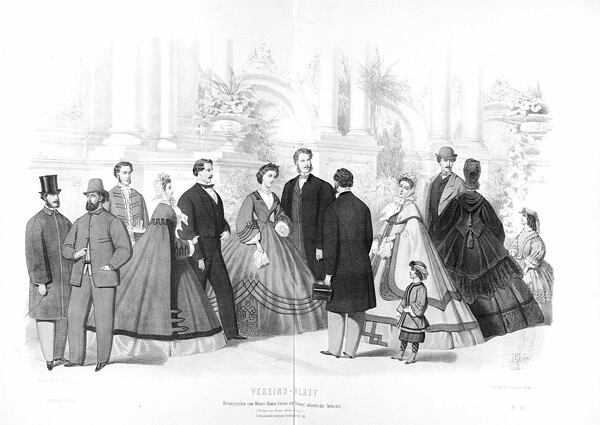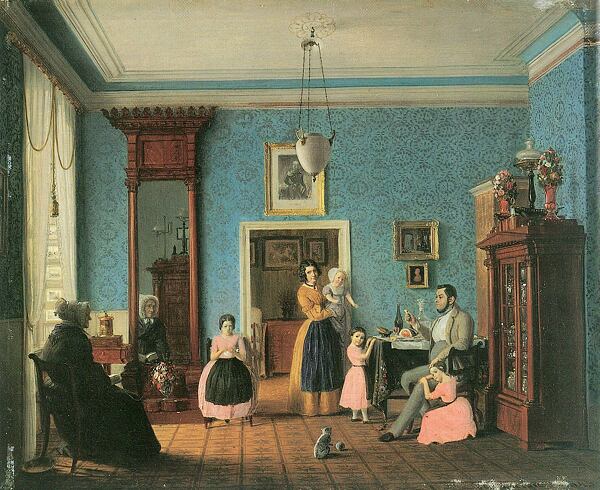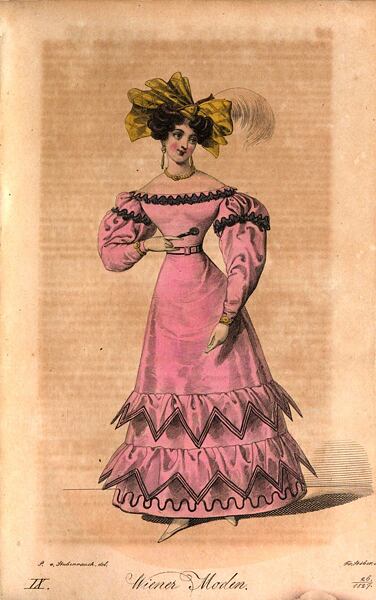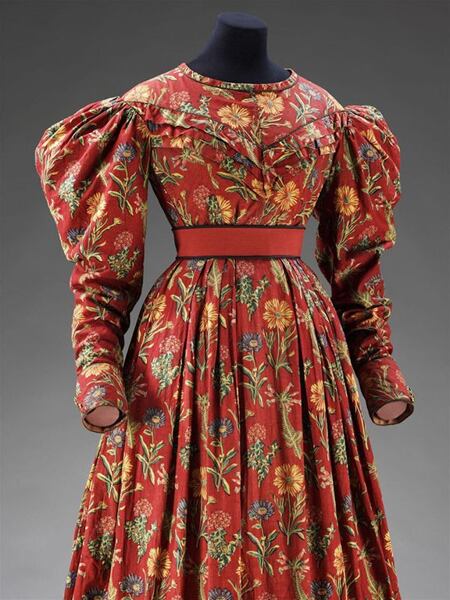
What is Biedermeier?
Browse through any guide to Prague or Vienna and you’re sure to stumble across it tucked away in reviews for coffee houses, exhibits, and hotels… Biedermeier. If you find yourself scratching your head, imagine yourself in Jane Austen’s England, then take a flying leap to Austria, and there you are.
For the historians among us, the Biedermeier covered a relatively brief historical window from the end of the Napoleonic wars and the Congress of Vienna in 1815 through the explosive revolutionary year of 1848. The term is used to describe the art and lifestyle prevalent at that time in the Austrian Empire and Prussia, though aspects of Biedermeier style spread to other parts of Europe as well. The period roughly coincides with the Regency and early Victorian era in British fashion and is similar in many respects.
Keep in mind that the first half of the 19th century was a time of uneasy peace on the European continent, marked by simmering political unrest and nascent revolutionary impulses. Austria did not intend to allow the pot to boil over. It imposed a strict regime with agents of the secret police keeping a close eye on the inhabitants of its sprawling empire. As a result, social life turned inwards and the growing urban middle class focused their energies on hearth and home.
Naturally, the era was not defined by politics alone. Industry, science, art, and crafts were developing in new and exciting ways. The decorative arts gained a special importance at this time – middle class families could not afford to hang masterpieces on their walls as the nobility did, but they still wanted to demonstrate their prosperity and good taste. A bourgeois household would have been well equipped with fashionably carved and upholstered (yet serviceable) furniture, paintings (portraits, family life in the countryside), beautiful carpets and wallpapers, opulent curtains, and myriad knickknacks like embroidered pillows and tablecloths. Some homes were equipped with the latest perks – gas lighting and indoor plumbing.
What characterized Biedermeier style
Typical traits of the Biedermeier period:
- Middle class at the fore
- Focus on home life, order, comfort, serviceability
- Quality craftsmanship
- Moderation and decorum replace extravagance
- Appreciation of nature
- Growing importance of industry, the steam age
Biedermeier fashion – What they wore
Although the Biedermeier period lasted only three decades, the silhouette transformed several times just like in Regency, along with accessories and fabrics. A few main characteristics of the period were constant.
- Contrast between a cinched waist and a drooping shoulder enhanced by huge sleeves
- Long, bell-shaped skirts
- Dainty floral patterns, both printed and woven
- Dresses trimmed in ruffles, frills, embroidery, applique
- Intricate, braided hairstyles tucked under a poke bonnet or cap during the day, embellished with combs, ribbons, and feathers in the evening
- Ladies kept themselves warm with long scarves, stoles, short capes called pelerines, and longer pelisses.

Fabrics with authentic Biedermeier prints

As the Biedermeier era took off, waistlines at first remained high, as they had been in the Empire period, but skirts began to widen.
By 1820 the waistline started to move south until it finally arrived at the midriff. Skirts became fuller each year and eventually hoops were again a necessity. Corsets made a comeback as well – indispensable for achieving the fashionably small waist. A notable style element were the sleeves, which were constantly changing – smallish puffs, huge gigot (leg-of-mutton) and pagoda styles, and then again narrow sleeves with a little puff here or there or a bit of ruffle.
In the years 1830–1848 Biedermeier was at its peak. A cinched waist with a full, gathered skirt and huge puffed sleeves formed a classic “X” shape. It was a silhouette that had been in fashion before, reaching extremes in the Spanish Renaissance and French Rococo, and was to return periodically in the future – in fact, the hourglass figure is experiencing yet another renaissance today.
In the 1850s and 1860s Biedermeier fashion in central Europe made way for the “second Rococo” and skirts achieved such volume that the wearer needed huge hooped underskirts reminiscent of the days of Marie Antoinette. Fashion moved away from floral Biedermeier fabrics to the more sophisticated look of the latter 19th century.




A note on our illustrations: The images above are culled from historical issues of the Viennese lifestyle magazine Wiener Zeitschrift für Kunst, Literatur, Theater und Mode, which are accessible online from the Austrian National Library. Ladies all over the Hapsburg Empire once scanned its pages eagerly for the latest fashions and had dresses sewn based on the illustrations.
Biedermeier period fabric
Biedermeier fashion utilized all of the natural fibers – silk, wool, cotton, and linen, both alone and in various blends. Evening gowns were generally made of the best a lady could afford – silk, lace, feathers, and furs – while cotton was popular for day dresses.
Cotton fabrics from India, in both solid colors and prints, had made their way to Europe in the seventeenth century. The exotic prints were a big hit and European manufacturers sought to copy them, but once the technical problems were overcome there were other obstacles – selling, or even wearing, printed cottons was forbidden. Some domestic fabric makers were so afraid that there would be no more demand for their goods that they pushed such policies as a way to restrict imports.
It seems, though, that industrial progress and customer demand were unstoppable. Technological advances in the 18th century meant that soon the process of fabric production was almost entirely mechanized. The only things still made exclusively by hand were lace, braiding, and accessories.
In the 1840s Bohemia was home to dozens of cotton printers turning out calicoes on simple plain-weave cottons as well as printed crêpe, batiste, muslin, and sateen. In the Biedermeier era only natural dyes were used but by the latter half of the 19th century synthetic colors, some of them rather toxic, came into play. Fabrics were printed with rollers or blocks – block prints are still used today for traditional textile printing in India, and for the white-on-blue folk print known as modrotisk in Bohemia, among others.
Floral motifs were especially popular in the Biedermeier era, carrying over from the earlier Regency period. Dainty flowers on light or dark backgrounds were common, as were colorful fabrics with large, bright blooms and more abstract patterns inspired by nature. The color palette included white and cream, pale blues and greens, golden yellow, a range of browns, and vibrant Turkey red.
Biedermeier fabrics today
Although it goes without saying that today’s fashion is dramatically different from that of the Biedermeier period, the fabrics of that time are just as popular now as they ever were. Cotton batiste, poplin, and similar fabrics with nature-inspired prints work well for warm-weather dresses and tops and make a pretty addition to any decor.


our collection of biedermeier fabrics
Are you a fan of Biedermeier styles?
Have you got a dress in a Biedermeier print?
We’d love to see photos of your creations!







Comments(0)